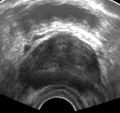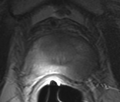Difference between revisions of "2014 Summer Project Week:MR-Ultrasound Registration for Prostate Interventions"
Chenchen78 (talk | contribs) |
|||
| (9 intermediate revisions by 2 users not shown) | |||
| Line 2: | Line 2: | ||
<gallery> | <gallery> | ||
Image:PW-MIT2014.png|[[2014_Summer_Project_Week#Projects|Projects List]] | Image:PW-MIT2014.png|[[2014_Summer_Project_Week#Projects|Projects List]] | ||
| + | Image:US-Case10.png | ||
| + | Image:MR-Case10.png | ||
| + | Image:MR-US-Case10-LandmarkRegistration.png | ||
</gallery> | </gallery> | ||
==Key Investigators== | ==Key Investigators== | ||
| − | Chenxi Zhang, SPL/FudanU | + | * Andriy Fedorov, SPL |
| − | + | * Chenxi Zhang, SPL/FudanU | |
| − | + | * Andras Lasso, Queens | |
| + | * Steve Pieper, Isomics | ||
==Project Description== | ==Project Description== | ||
<div style="margin: 20px;"> | <div style="margin: 20px;"> | ||
| − | Prostate cancer is a kind of common cause of cancer in men in many countries.Transrectal | + | Prostate cancer is a kind of common cause of cancer in men in many countries. Transrectal ultrasound (TRUS) is the most commonly used modality for guiding needle biopsies and minimally-invasive surgical interventions for the treatment of prostate cancer. However,it is difficult to accurately distinguish tumors in B-mode TRUS images. Magnetic resonance (MR) is a very promising technique for prostate biopsies and prostate interventions. Disadvantages of MR-guided prostate biopsies and prostate interventions are that MRI is an expensive method and not widely available. MR-Ultrasound registration can improve TRUS imaging and take advantages of both modalities. The object of this project it to develop a method of MR-Ultrasound image registration for prostate intervention. |
| − | |||
<div style="width: 27%; float: left; padding-right: 3%;"> | <div style="width: 27%; float: left; padding-right: 3%;"> | ||
<h3>Objective</h3> | <h3>Objective</h3> | ||
| − | * | + | * Investigate a method of MR-Ultrasound images registration for prostate intervention. |
</div> | </div> | ||
<div style="width: 27%; float: left; padding-right: 3%;"> | <div style="width: 27%; float: left; padding-right: 3%;"> | ||
<h3>Approach, Plan</h3> | <h3>Approach, Plan</h3> | ||
| − | * | + | * Continue development and evaluation of a method based on non-rigid registration of distance maps of the gland segmentation |
| + | ** Extract prostate from MR image and Ultrasound image | ||
| + | ** Calculate distance maps for segmented MR image and Ultrasound image | ||
| + | ** Do registration for distance maps of MR image and Ultrasound image using Slicer module of "BRAINSFit" | ||
| + | * Investigate alternative approaches available within the group | ||
| + | * We made [http://slicer.kitware.com/midas3/folder/2215 a test dataset] publicly available. If you have a method that works on this dataset, let us know. We have expert annotations that we can use to calculate registration error and evaluate your approach. | ||
</div> | </div> | ||
<div style="width: 27%; float: left; padding-right: 3%;"> | <div style="width: 27%; float: left; padding-right: 3%;"> | ||
<h3>Progress</h3> | <h3>Progress</h3> | ||
| − | * | + | * Presented this registration problem at the Prostate IGT breakout session |
| + | * Discussed alternative approaches: applied LandmarkRegistration module of Slicer for manually guided registration | ||
| + | * Steve added sample dataset has been added to the Slicer SampleData module | ||
</div> | </div> | ||
</div> | </div> | ||
Latest revision as of 13:34, 27 June 2014
Home < 2014 Summer Project Week:MR-Ultrasound Registration for Prostate InterventionsKey Investigators
- Andriy Fedorov, SPL
- Chenxi Zhang, SPL/FudanU
- Andras Lasso, Queens
- Steve Pieper, Isomics
Project Description
Prostate cancer is a kind of common cause of cancer in men in many countries. Transrectal ultrasound (TRUS) is the most commonly used modality for guiding needle biopsies and minimally-invasive surgical interventions for the treatment of prostate cancer. However,it is difficult to accurately distinguish tumors in B-mode TRUS images. Magnetic resonance (MR) is a very promising technique for prostate biopsies and prostate interventions. Disadvantages of MR-guided prostate biopsies and prostate interventions are that MRI is an expensive method and not widely available. MR-Ultrasound registration can improve TRUS imaging and take advantages of both modalities. The object of this project it to develop a method of MR-Ultrasound image registration for prostate intervention.
Objective
- Investigate a method of MR-Ultrasound images registration for prostate intervention.
Approach, Plan
- Continue development and evaluation of a method based on non-rigid registration of distance maps of the gland segmentation
- Extract prostate from MR image and Ultrasound image
- Calculate distance maps for segmented MR image and Ultrasound image
- Do registration for distance maps of MR image and Ultrasound image using Slicer module of "BRAINSFit"
- Investigate alternative approaches available within the group
- We made a test dataset publicly available. If you have a method that works on this dataset, let us know. We have expert annotations that we can use to calculate registration error and evaluate your approach.
Progress
- Presented this registration problem at the Prostate IGT breakout session
- Discussed alternative approaches: applied LandmarkRegistration module of Slicer for manually guided registration
- Steve added sample dataset has been added to the Slicer SampleData module



